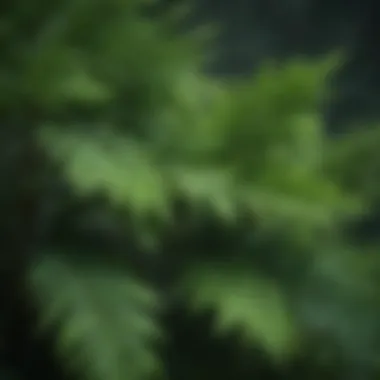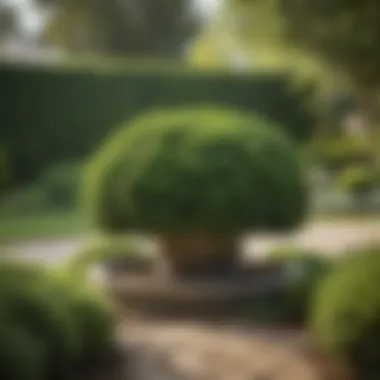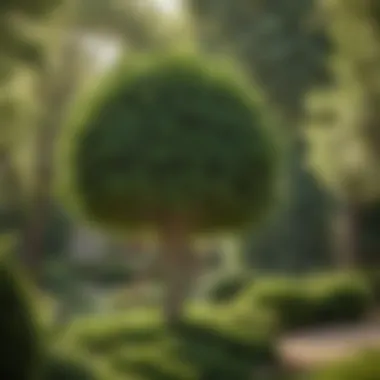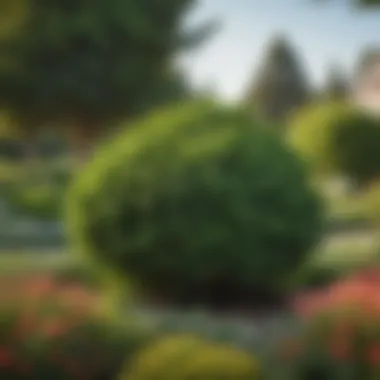Emerald Green Arborvitae: Care and Landscape Benefits


Intro
Emerald Green Arborvitae, scientifically known as Thuja occidentalis 'Emerald Green', is popular among gardeners and landscape designers for its unique characteristics and ease of maintenance. This enciphered evergreen plant stands out in the landscape due to its vibrant green foliage and symmetrical shape. What could be more appealing than a shrub that not only enhances beauty but also serves practical functions in gardens?
In this guide, we will explore the anatomy, care requirements, and landscape applications of this fascinating species. As we investigate the anatomy, we will detail its structure, highlighting features that contribute to its resilience and longevity. Additionally, we will discuss the elements essential for proper care, enabling this tree to thrive while maintaining its visual appeal. Lastly, we will delve into various landscape uses, showcasing how the Emerald Green Arborvitae can be employed as a focal point or backdrop in diverse settings.
Through this valuable information about the Emerald Green Arborvitae, readers will be empowered with knowledge and tips, allowing them to successfully incorporate this timeless evergreen into their environments.
Anatomy of Emerald Green Arborvitae
Physical Characteristics and Appearance
Emerald Green Arborvitae is recognized for its narrow, pyramidal form, which typically grows between 10 to 15 feet in height and can spread up to 3 to 4 feet wide. The dazzling, lush foliage boasts vibrant green color year-round, adding notable visual interest. The needle-like leaves are flattened and scale-like, which contribute to its ornamental texture.
In fall and winter, the foliage takes on a subtle hint of bronze, enhancing the overall seasonal aesthetics.
Not only pleasing to the eye, but the density of the leaves offers a gentle sound barrier. This makes the Arborvitae a common choice for privacy screens in residential landscapes.
Natural Habitat and Distribution
Native to North America, the Emerald Green Arborvitae thrives in a variety of conditions but demonstrates its best growth in well-draining soil and full sun exposure. It is often found in mixed forests and wetlands, showcasing its adaptability to moisture levels. However, it prefers environments that provide some humidity and can tolerate different soil types, making it suitable for many areas.
Care Requirements
Optimal Environmental Conditions
To provide optimal conditions for the Emerald Green Arborvitae, consider the following aspects:
- Sunlight: Although it can tolerate some shade, preferably place it in full sun for at least six hours per day.
- Soil: Regular garden soil with good drainage is ideal. Heavy clay, however, should be avoided, as it might induce root rot.
- Watering: It’s vital to ensure that the soil remains consistently moist, especially during periods of extended dry weather.
Maintenance Practices
Effective maintenance practices help sustain the health of the Emerald Green Arborvitae:
- Pruning: Limit pruning to shaping and removing injured branches, ideally in late winter.
- Fertilizing: Organic mulch around the base can regulate soil moisture and suppress weeds.
- Pest Management: Regular inspections for signs of pests like spider mites or aphids can ensure its longevity.
Landscape Applications
The Emerald Green Arborvitae is perfect for various landscape applications. The ornamental structure works brilliantly as a:
- Privacy Screen: Its dense growth provides an effective barrier against neighbors and noise.
- Hedge: Plant in rows for formal hedging.
- Focal Point: Use as a standalone feature accentuated by colorful flowers.
More than aesthetics, this species is involved in sustaining biodiversity. Emerald Green Arborvitae can provide nesting sites for various birds, enriching the ecological dynamic of gardens.
By understanding and applying the principles discussed above, one can enrich their landscape intelligently and beautifully with the Emerald Green Arborvitae. From its anatomy to its care requirements, each aspect builds upon the plant's capability to thrive in various settings.
Prolusion to Emerald Green Arborvitae
Emerald Green Arborvitae is an essential plant in landscaping, known for its unique architectural form and vibrant leaves. This shrub not only adds beauty but also provides functionality in various garden settings. Understanding its anatomy and care requirements is crucial for gardeners and landscape designers alike.
Taxonomy and Nomenclature
The formal classification of the Emerald Green Arborvitae is Thuja occidentalis. It is part of the Cupressaceae family. This nomenclature helps in identifying and differentiating it from other Arborvitae varieties. Recognizing the appropriate classification is fundamental when researching specific care or ecological roles.
Physical Characteristics
Foliage Description
Emerald Green Arborvitae showcases dense and rich emerald-colored foliage that remains vibrant year-round. The leaves are scale-like, which gives them a unique texture. This characteristic adds considerable interest to landscapes, creating visual appeal in all seasons. Because of its lush greenery, it is a popular choice for hedges and privacy screens.
Growth Habit
This shrub tends to grow in a columnar shape, making it an ideal choice for formal gardens or where space efficiency is needed. The upright growth habit provides visual elevation without sprawling outwards, fitting perfectly into limited spaces. This quality makes it highly adaptable to various landscape designs. It offers a strong architectural presence with minimal growing effort required.


Height and Width Expectations
The Emerald Green Arborvitae typically reaches a height of about eight feet and maintains a width of approximately three to four feet. These dimensions make it suitable for various landscape applications, illustrating both vertical and horizontal dimensions without overwhelming surrounding plants. Gardeners utilising this shrub can plan features that incorporate depth while maximizing space through strategic placement.
It's important to understand the potential growth of plants like the Emerald Green Arborvitae. Knowing that these can reach significant heights aids in making informed choices in garden design and arrangement.
Cultivation and Growth Requirements
Cultivation of Emerald Green Arborvitae not only ensures its well-being but also enhances the integral role it plays within diverse landscapes. Understanding its growth requirements is crucial for achieving optimal plant health and aesthetics. This section will cover its preferences for soil composition, light exposure, and water needs—each contributing factors that directly impact the plant's success.
Ideal Soil Conditions
The ideal soil conditions for Emerald Green Arborvitae are fundamental for its growth. This species prefers well-drained, moderately fertile soils. A mixture containing loamy texture supports root development effectively. Soil that retains moisture but drains excess water helps to prevent root rot and other water-related issues.
Organic matter enhancement, such as compost or well-rotted leaf mulch, further enriches the soil, ensuring that essential nutrients are readily available. It is important to conduct a soil test before planting to check pH levels. An ideal range for Arborvitae lies between 6.0 and 8.0, as both acidic and alkaline soils can alter the nutrients available to the plant.
Light Preferences
Emerald Green Arborvitae thrives best in full sun to partial shade conditions. Ideally, it requires about six hours of direct sunlight each day. Adequate sunlight ensures the rich green color of foliage is preserved, enhancing its visual appeal in any landscape setting. Inadequate light often leads to stunted growth and a sparse appearance.
To maximize growth potential, consider integrating these trees into sunny areas. If planted in shaded spots, growth may be less vigorous, which affects both height and width expectations over time. Observing light conditions before and after planting enables better planning. This is particularly relevant in landscapes involving trees or structures that may cast long shadows.
Watering Needs
The watering requirements of Emerald Green Arborvitae must be met, especially during its establishment phase. Newly planted trees need regular watering to ensure mosture reaches the roots. It's crucial to prevent the soil from becoming overly dry, especially in hot, dry seasons.
Once established, this species demonstrates a moderate tolerance to drought. However, periodic irrigation during extreme conditions can assist in maintaining plant vigor. Generally, a deep watering every two to three weeks will suffice each growing season. Overwatering, however, can also be detrimental, leading to diseases like root rot.
Adequate watering practices are essential for supporting overall health in cultivated Emerald Green Arborvitae. Without this balance, even the best soil and light situations cannot sustain a thriving plant.
Thus far, understanding these cultivation aspects lays a strong foundation for successful Arborvitae care. Cultivating them under the right conditions enhances beauty, wildlife interaction, and ecological health—all highlighting their significance in landscaping.
Planting Techniques
Planting techniques are essential when considering the successful establishment of Emerald Green Arborvitae. Proper placement and techniques can greatly affect the growth and longevity of this evergreen shrub. Primarily, it helps ensure that the plants thrive in their chosen environments A well-planted Arborvitae contributes robustly to garden aesthetics and biodiversity. Understanding how to select the ideal site, adequate spacing, and effectively plant these trees can lead to remarkable results
Site Selection
Selecting the right site for the Emerald Green Arborvitae is crucial. These evergreen shrubs prefer well-drained soils and areas with partial to full sunlight. Avoid low spots where water tends to stagnate, as excess moisture can lead to root rot. Consider the existing plants and landscaping around the site; Avality of space will be key, especially as the Arborvitae matures.
- Evaluate sunlight: Quarry that the Bush is planted in a sunlit spot for at least six hours per day.
- Examine soil: Soil should haev a pH between 6.0 and 8.0, with organic matter mixed in to aid drainage. Testing the soil beforehand can facilitate informed decisions.
- Observe temperature and wind exposure: Emerald Green Arborvitae is hardy to about -40° F. However, protecting these plants from extreme wind is a practical consideration in colder climates.
Spacing Considerations
When planting Emerald Green Arborvitae, spacing is an often understated but crucial aspect. Reasonably providing adequate space between multiple shrubs is vital for air circulation, access to sunlight, and ensuring optimal growth.
- Standard Spacing: Typically, these Arborvita?s should be spaced at least 3 to 4 feet apart. This encourages each plant to grow without competing excessively for nutrients.
- Privacy Screens: For purposes such as privacy screens or windbreaks, consider closer spans of about 2 to 3 feet.
- Wide Growth Prairie: Think about growth habits of the shrub. They can expand not only vertically but also horizontally, so allow room as they mature.
Best Practices for Planting
Implementing best practices during the planting process significantly enhances the likelihood of survival and growth of the Emerald Green Arborvitae.
- Dig Wisely: Create a hole that is two to three times as wide as the plant's root ball, but no deeper. This encourages root expansion.
- Natural Fertilization: Consider mixing in native soil with organic compost at the base of the root ball before backfilling.
- Water Adequately: Ensure the shrub is thoroughly watered right after planting to eliminate air pockets and successfully hydrate the roots.
- Mulch: Adding a layer of mulch around the base can reduce moisture evaporation and suppress weeds,
- Stake If Necessary: For smaller plants or young trees in spaces prone to significant winds, it’s recommended to stake the plants for the first growth season.
The thoughtful application of these planting techniques will benefit not only the homeowner but also the larger ecosystem surrounding the Emerald Green Arborvitae, promoting widely-needed greenery and supporting local wildlife.
Understanding these essential concepts contributes to the sustainable management of this favored ornamental plant.
Maintenance and Care
Maintaining and caring for the Emerald Green Arborvitae is crucial for its longevity and overall appearance. Proper maintenance enhances the resilience of the plant and ensures it contributes positively to the landscape. Regular care activities also improve the plant's ability to withstand pests and diseases, leading to healthier trees that last throughout the years.
Pruning and Shaping


Pruning focuses on removing dead or excess branches. Manufacturers should prune to maintain the shape and promote healthy growth. This prevention method assists in allowing airflow and light penetration, crucial factors for tree health. 7 molecular hormones encourage growth. The ideal time for pruning is late winter before new growth appears, avoiding cold tongue to the cambium layer in spring or early fall which can stress the tree.
Technique Tips:
- Start by removing dead wood first.
- Ensure your tools are sharp to make clean cuts.
- Shape for a natural look and avoid excessive shearing, which can lead to a lack of foliage.
- Pull the cut of 1 další larger twist branches to promote new sprouts.
Fertilization Strategies
Fertilizing Emerald Green Arborvitae supports its growth. Due to the standard variance in soil nutrient levels, a balanced fertilizer provides essential nutrients. This activity can particularly impact the plant's health, ensuring it gets a scaffold expansion to bloom consistently. NPK ratios of up to 10-10-10 or similar can work well. Incorporating an organic slow-release fertilizer makes nitrogen available in summer's warmth.
When to Fertilize:
- Apply in early spring when the ground is soft.
- Avoid variables near late fall; fertilizer high in nitrogen can cause tender young growth at risk of frost.
Common signs for fertilizer need include yellowing leaves or little growth. Observation of symptoms indicates ineffective soil care. A yearly check for soil pH via simple testing can offer good information on necessary adjustments.
Seasonal Care Guidelines
Attention to seasonal tasks leads to optimal growth. As each season brings specific needs, appropriate actions are crucial. Emerald Green Arborvitae thrives with meticulous habit maintenance fitting to the monthly calendar.
Spring:
- Fertilization: Begin spring with nutrient application.
- Mulching: Add a protective layer to aid moisture retention as temperatures rise.
Summer:
- Watering: Keep soil consistently damp. Water deeply to protect roots from temperature fluctuations fostering evaporation.
- Pest Checks: Look for early signs like webs inside foliage; follow treatment if necessary.
Fall:
- Prepare for Winter: Shrub wrap constructed from burlap protects from cold.
- End of Year Prune: Minor shaping (any vulnerable harm matters).
Winter:
- Cautiously watch snow build by gently brushing intervening limbs.
- Assess modify checks before latent trimming and nutrient adjustments come next.
Overall, dedication to maintenance not only keeps this species visually appealing but also aligns growth with the rhythmic seasonal changes.
Pest and Disease Management
Pest and disease management plays a crucial role in the healthy growth of the Emerald Green Arborvitae. Given its popularity in landscaping, understanding how to best protect this shrub elevates its longevity and aesthetic value. Estates and gardens featuring these plants can suffer significant damage if common pests and diseases are not actively monitored. Regular vigilance ensures optimal development and contributes positively to one's landscape architecture.
Common Pests
The Emerald Green Arborvitae can be afflicted by a range of pests. Each type poses a threat that varies in risk:
- Spider Mites: Tiny yet impactful, spider mites thrive in dry conditions. They cause foliage damage, which typically appears as yellowed or stippled leaves.
- Bagworms: These caterpillars create their distinct silk and plant-debris bags. Infestations break down the overall health of Arborvitae, leading to foliage loss.
- Scale Insects: Generally considered a nuisance, these insects draw sap from plants, hindering growth. They can create a sticky residue, attracting further secondary pests.
Taking quick action upon noticing signs of these pests is paramount to maintaining plant health.
Diseases Affecting Arborvitae
Diseases can significantly impact Arborvitae, threatening aesthetic appeal and structural integrity.
- Phytophthora Root Rot: Often linked to poor drainage, this disease can lead to sudden plant decline. Identifying drainage issues can help mitigate risks.
- Fungal Diseases: Common fungal issues include leaf blight. This manifests through unattractive spots on foliage, which usually leads to overall weakening of the plant through nutrient drain.
- Cedar Apple Rust: A distinct threat to not only Arborvitae but related species. Characterized by yellow-orange galls that form on transitory species, it reduces plant strength and vitality.
Awareness for these diseases is critical to implement supportive measures early.
Preventative Measures
Proper management demands robust preventative measures:
- Regular Inspection: Frequent checks of the plant can lead to early detection of pests or symptoms of disease.
- Proper Watering Techniques: Over-watering can contribute to various diseases. Achieving a balance in soil moisture levels preserves roots.
- Fertilization: Adequate nourishment supports healthy growth and resilience against pests and diseases.
- Pruning: Maintaining good air circulation through careful pruning reduces localized damp conditions conducive to disease growth.
- Mulching: Protective mulching assists with moisture control while preventing weeds and providing drainage aid.


Implementing these methods not only enhances the health of Emerald Green Arborvitaes but also enriches the surrounding ecosystem.
Maintaining an organic approach can often be good strategy. Fewer chemicals permit a stronger beneficial bug population, which assists in controlling pest outbreaks naturally.
Observing these principles extensively will secure the integral beauty and survival of the Emerald Green Arborvitae through dynamic environmental conditions.
Ecological Importance
Emerald Green Arborvitae plays a significant role in the local ecosystem. Its presence enhances the environment in various ways, thus providing essential benefits to both wildlife and the surrounding plant life. This section will explore how the Arborvitae influences its habitat and contributes to ecological balance.
Role in Local Ecosystems
Emerald Green Arborvitae is not just a visually appealing plant. Its lush foliage offers various ecological functions. This species acts as a windbreak, reducing soil erosion and capturing airborne particles. Furthermore, it establishes a shelter for numerous bird species and insects. Such interactions within the ecosystem create a healthier environment. The tree absorbs carbon dioxide while releasing oxygen, which supports plant and animal life.
Habitat for Wildlife
The dense structure of the Emerald Green Arborvitae make it an ideal habitat for various wildlife. Birds such as chickadees and wrens often nest within its branches. Additionally, smaller mammals use the trees for cover or as a food source during winter. Research demonstrates that evergreen plants like Arborvitae provide safer environments for young wildlife, increasing their survival rates. Ample leaf coverage encourages a thriving insect population, which serves as food for various other creatures.
Contribution to Biodiversity
Emerald Green Arborvitae also promotes biodiversity. The tree enhances the complexity of the habitat, making it suitable for more species to thrive. A more diverse ecosystem is less vulnerable to diseases and climate changes. By offering a persistent green presence, the Arborvitae helps in supporting resistance against pests, as its canopy creates a less inviting atmosphere for harmful insects.
Biodiversity contributes to the resilience of an ecosystem, ensuring willful survival of various species in adjusting conditions.
A range of plant species that flourish near Arborvitae adds to its overall contribution. This diverse mix benefits pollinators such as bees and butterflies. Such interactions emphasize the need to incorporate this species into landscaping not merely for aesthetic purposes but also for environmental advantages it provides. By understanding the ecological importance of Emerald Green Arborvitae, gardeners and landscape designers can make informed choices to support local ecosystems.
Landscape Applications
The landscape applications of Emerald Green Arborvitae detail their usefulness within garden design and yard enhancement. These evergreen trees offer several practical benefits that make them a popular choice among landscape architects and homeowners. They serve not only aesthetic purposes but functional roles as well.
Use in Privacy Screens
Emerald Green Arborvitae is often favored for creating privacy screens. Their densely packed foliage provides a natural barrier against outside observers, enhancing the feeling of seclusion in outdoor spaces. They can grow tall and are suitable for residential settings where privacy is valued. When planted closely together, they can seam to form an uninterrupted green wall, blocking views from neighbors and nearby streets.
Considerations when utilizing these trees for privacy include:
- Space for planting: Ensure adequate spacing between plants for optimum growth.
- Soil suitability: As previously discussed, their growth is best in well-draining soil.
- Maintenance: Regular trimming ensures that the trees maintain desired height and shape.
An effective privacy screen not only offers seclusion but also contributes to noise reduction, providing a more peaceful garden environment.
Aesthetic Value in Gardens
The aesthetic contribution of Emerald Green Arborvitae cannot be overlooked. Their vibrant green color remains stable throughout the year, offering visual interest in all seasons. These trees can act as stunning focal points or elements in garden design.
For landscaping, their form allows for various planting styles:
- Symmetrical Arrangements: Their upright growth pattern enhances cultivated or formal designs.
- Layered Planting: For a more natural feel, combining these trees with shrubs and perennials creates depth.
- Container Integration: Smaller specimens can also be used in pots, functioning as decorative items in pathways or entryways.
In summary, their visual impact is substantial, adding elegance and formal structure to any garden layout.
Types of Landscaping Projects
Emerald Green Arborvitae fits numerous types of landscaping projects. Its versatility allows for integration in various design themes and functional needs:
- Residential Gardens: Homeowners often choose them for garden borders and background plantings.
- Commercial Properties: Businesses value their capacity to enhance curb appeal while offering functionality.
- Public Parks: They can provide greenery in parks or recreational areas, acting as warm hedges or tree lines.
Ultimately, their adaptability makes them suitable for both small-scale gardens and larger commercial installations, sustaining a blend of aesthetics and functionality in numerous settings.
Closure
The Emerald Green Arborvitae serves not only as an aesthetic choice but also plays a crucial role in landscape design and ecological balance. Its adaptability to various environments makes it a valuable asset for gardeners and landscape designers. By understanding its anatomy, care requirements, and applications, one can maximize its potential.
Recap of Key Points
- Taxonomy and Anatomy: Emerald Green Arborvitae, a member of the Thuja genus, stands out with its dense, lush foliage.
- Cultivation Needs: This species requires specific soil conditions, proper sunlight, and a defined watering schedule to thrive.
- Plant Care Practices: Routine maintenance, such as systematic pruning, coupled with effective fertilization enhances its growth and lifespan.
- Pest and Disease: Awareness of potential pests and diseases can lead to better management strategies, ensuring robust health.
- Ecological Value: Its role within local ecosystems and as wildlife habitat promotes biodiversity.
- Landscaping Features: Whether used for privacy screens or aesthetic enhancement in gardens, its versatility is unmatched.
Final Thoughts on Emerald Green Arborvitae
Incorporating the Emerald Green Arborvitae into your landscape is both a commendable choice from an aesthetic and ecological perspective. This plant provides privacy, improves biodiversity, and offers year-round beauty with minimal maintenance. From understanding detailed traits to applying best care practices, the knowledge gained from this article empowers you to effectively use this evergreen shrub. Adaptability and ecological benefits underline its significance in landscaping and gardening practices today.
"Emerald Green Arborvitae serves as a reminder of how thoughtful landscaping choices can enhance both beauty and ecological health."







